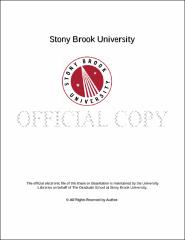| dc.identifier.uri | http://hdl.handle.net/11401/77395 | |
| dc.description.sponsorship | This work is sponsored by the Stony Brook University Graduate School in compliance with the requirements for completion of degree. | en_US |
| dc.format | Monograph | |
| dc.format.medium | Electronic Resource | en_US |
| dc.language.iso | en_US | |
| dc.publisher | The Graduate School, Stony Brook University: Stony Brook, NY. | |
| dc.type | Dissertation | |
| dcterms.abstract | In benthic marine invertebrates with complex life cycles, dispersal happens primarily during the larval stage: sedentary, benthic adults produce larvae that live in the water column for a period of hours to months. The larval life stage is therefore critical to the ability of a species to expand or shift its range, including in response to climate change. Species with planktonic larvae are expected to show greater dispersal and gene flow than those with direct development. In contrast, reduced gene flow among populations of directly developing species increases the potential for local adaptation. Understanding not only larval traits, but population-level processes, is critical to predict how individual species may shift their ranges in response to climate change. The genus <italic>Crepidula</italic> (Gastropoda: Calyptraeidae) contains many species with different developmental modes. In this dissertation, I used a planktonic developer (<italic>C. fornicata</italic>) and a direct developer (<italic>C. convexa</italic>) to assess genetic diversity and dispersal potential across larval types. Using microsatellite markers, I found that <italic>C. convexa</italic> has high levels of genetic structure within its native range, unlike <italic>C. fornicata</italic>. An introduced population of <italic>C. convexa showed high levels of genetic diversity, concurrent with previous results in <italic>C. fornicata</italic>. I used next-generation sequencing data to test the hypothesis that marginal populations of both species show reduced genetic diversity. I did not find a reduction in genetic variation, but found that marginal populations of <italic>C. fornicata</italic> are distinct from each other and from more central populations. I then focused on <italic>C. fornicata</italic> for a study of how larval settlement changes in response to adult density. I found that increased adult density leads to increased settlement, meaning that range edges may show low rates of settlement. The final chapter of this dissertation focused on the mechanism of settlement in <italic>C. fornicata</italic>. I conducted lab experiments to measure settlement in the presence of chemical cue from adult conspecifics. These experiments showed that larvae settled in response to two different cues from adults, a waterborne cue and one carried in adult pedal mucus, and that the waterborne cue could be partially inactivated by heat. Taken together, these studies represent an understanding of ecological and genetic processes that may affect the speed of climate-driven range shifts in these <italic>Crepidula</italic> species. | |
| dcterms.available | 2017-09-20T16:52:37Z | |
| dcterms.contributor | Padilla, Dianna | en_US |
| dcterms.contributor | Levinton, Jeffrey S | en_US |
| dcterms.contributor | Futuyma, Douglas | en_US |
| dcterms.contributor | Eanes, Walter | en_US |
| dcterms.contributor | Viard, Frederique. | en_US |
| dcterms.creator | Cahill, Abigail Eileen | |
| dcterms.dateAccepted | 2017-09-20T16:52:37Z | |
| dcterms.dateSubmitted | 2017-09-20T16:52:37Z | |
| dcterms.description | Department of Ecology and Evolution. | en_US |
| dcterms.extent | 144 pg. | en_US |
| dcterms.format | Application/PDF | en_US |
| dcterms.format | Monograph | |
| dcterms.identifier | http://hdl.handle.net/11401/77395 | |
| dcterms.issued | 2014-12-01 | |
| dcterms.language | en_US | |
| dcterms.provenance | Made available in DSpace on 2017-09-20T16:52:37Z (GMT). No. of bitstreams: 1
Cahill_grad.sunysb_0771E_12077.pdf: 2226048 bytes, checksum: f0f7e54668e377e3f93e301f3128c551 (MD5)
Previous issue date: 1 | en |
| dcterms.publisher | The Graduate School, Stony Brook University: Stony Brook, NY. | |
| dcterms.subject | biogeography, gastropod, invertebrate, larval settlement, population genomics, range limits | |
| dcterms.subject | Ecology | |
| dcterms.title | The role of developmental mode and population-level processes in shifting distributions: a study of calyptraeid gastropods | |
| dcterms.type | Dissertation | |

